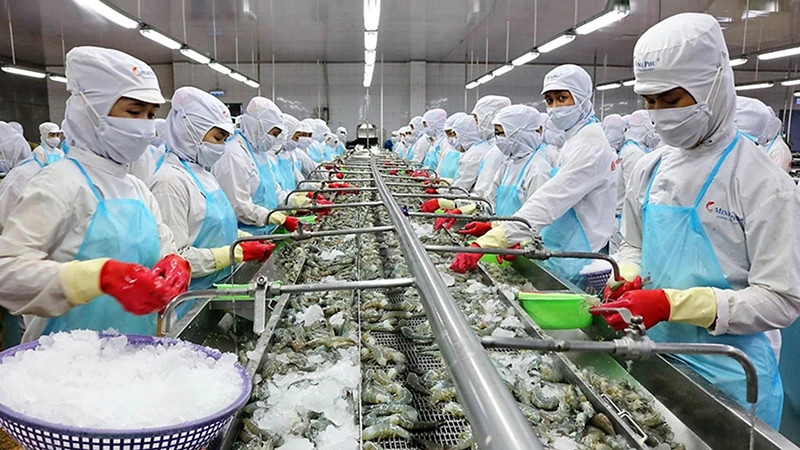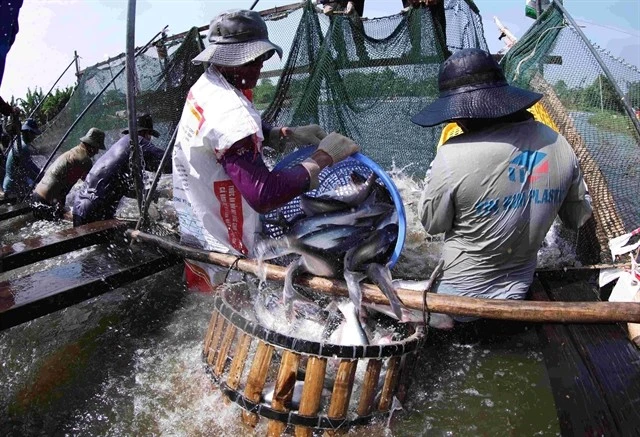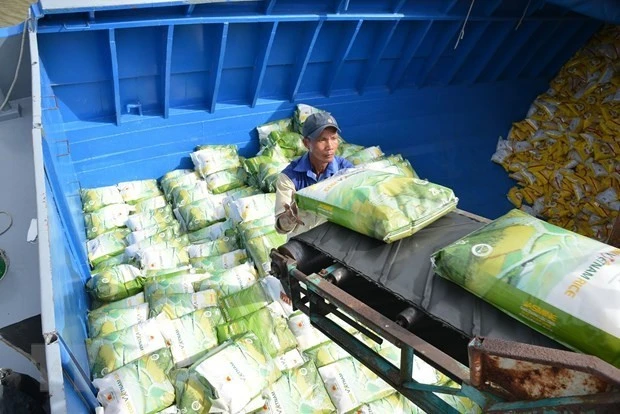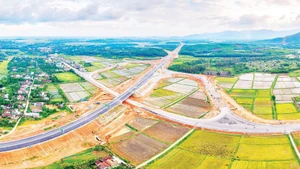As of the end of July, the cumulative shrimp export reached nearly two billion USD, an increase of 7% over the same period in 2023. White-leg shrimp reached 1.45 billion USD, up 4%, and Black tiger shrimp reached 246 million USD, down 10% against the same period in 2023. Lobster exports alone increased nearly three times, reaching 145 million USD.
Difficulties hinder export momentum
The recovery momentum for Vietnam's shrimp exports has faced many difficulties since the beginning of 2024. Shrimp exports started strongly in January 2024 with a 71% increase compared to the same period in 2023, earning 242 million USD.
However, shrimp exports faced difficulties in the following months. Compared to the same period in 2023, February decreased by 11% to 173 million USD (due to coinciding with the Lunar New Year). March reached nearly 272 million USD, up 3% and April reached 287 million USD, up 0.2%.
Although Vietnam's shrimp exports increased sharply in June and July, bringing the cumulative total for the first six months and seven months of the year to 1.6 billion USD and nearly 2 billion USD, respectively, the statistics do not fully reflect the overlapping difficulties. This year, shrimp exports continue to face many disadvantages and challenges due to the impact of the Russia-Ukraine conflict, the global economic crisis, high inflation in major export markets, technical barriers to imported shrimp, price competition with India and Ecuador, increased shipping costs, complicated disease developments in farmed shrimp, high shrimp production costs and the risk of raw material shortages.
General Secretary of the Vietnam Association of Seafood Exporters and Producers (VASEP) Truong Dinh Hoe said, that although the shrimp industry is experiencing positive growth in the first months of 2024, this does not accurately reflect the reality of simultaneous difficulties in all major markets such as the US, the EU, and Japan.
In the US market (Vietnam's largest shrimp export market in 2023, with a revenue of 682 million USD), the US Department of Commerce issued a conclusion on August 2, continuing to identify Vietnam as a non-market economy, which means that Vietnamese exporting enterprises to the US market continue to be discriminated against in US anti-dumping and anti-subsidy investigations.
The actual production costs of Vietnamese enterprises continue to be not recognised but must use the “replacement value” of a third country to calculate the dumping margin. Thus, right in the key US market, Vietnamese shrimp is at a disadvantage.
According to data from Vietnam Customs, as of June 15, Vietnamese shrimp exports to the US reached more than 262 million USD, up 2% over the same period in 2023. After increasing in the first months of the year, shrimp exports to the US decreased again in April and May, due to high inflation and Americans tightened spending. Shipping costs increased dramatically and there was strong price competition with shrimp from Ecuador and India.
In the first 5 months of 2024, China, from the second position of the previous year, unexpectedly surpassed the US to become Vietnam's largest shrimp consumption market.
It is forecasted that by the end of the year, China will be a place of strong price competition between Vietnamese shrimp and shrimp from Ecuador, India and Indonesia, where in the first six months of the year, China imported 436,000 tonnes of shrimp, shrimp from Ecuador alone reached 330,000 tonnes, accounting for 75%.
In the logistics segment, export companies said that since May, shipping costs have increased dramatically by more than 40%, due to rising fuel prices, goods having to go around to avoid areas of war and conflict, and also because many countries are collecting empty containers to reserve for export, causing rental prices to skyrocket.
The characteristics of the seafood industry, as well as many other agricultural products, require refrigerated containers and transportation time is crucial. The high freight rates will put Vietnamese shrimp exports at a disadvantage when competing on price in overseas markets.
Domestically, diseases in farmed shrimp are complicated and have not been overcome, typically white liver opacity disease TPD. In many farming areas, farmers are not interested in breeding when the disease increases, prices are low, the possibility of a successful harvest is low, and the possibility of losses is high, causing the risk of a shortage of raw materials for export in the last months of the year.
Mr Le Tien Luat, in Dat Do District, Ba Ria-Vung Tau Province, said his family has 17 shrimp ponds on nearly six hectares. Recently, shrimp prices have dropped sharply, and the weather is not favourable, causing slow growth of farmed shrimp, high costs, and high losses, causing farmers to suffer losses.
He has now decided to stop farming, waiting until the price stabilises before resuming production. According to shrimp farmers in Dat Do District, the current selling price of commercial shrimp is about 120,000 VND/kg, but the cost that farmers spend is also nearly 120,000 VND/kg. With this selling price, farmers must be very “lucky” to make a profit, if the price drops further, they will suffer heavy losses.
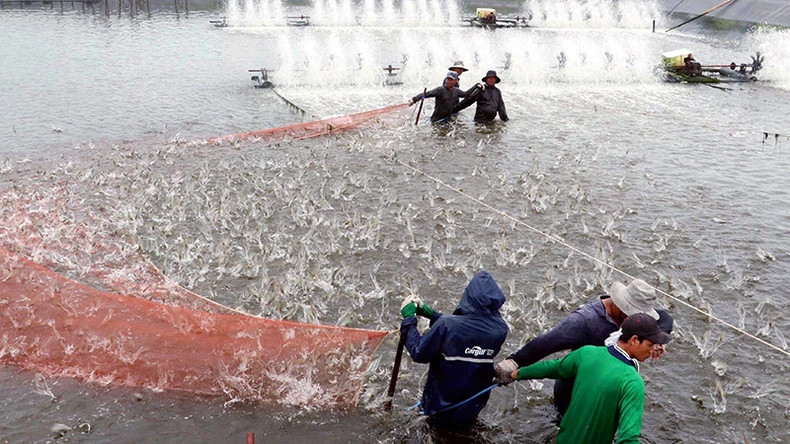 |
| Harvesting shrimp farmed using a high-tech model in Soc Trang Province. (Photo: Trung Hieu) |
Changing strategies, accelerating at the end of the year
However, in the face of general difficulties, the Vietnamese shrimp industry maintains its growth momentum. According to VASEP, in July, the export revenue of all key aquatic products improved. Shrimp exports alone increased by 11%, the highest growth rate since the beginning of the year. Shrimp exports to China and the EU increased by 24% and 32% respectively, while exports to the US increased by 9%, to Japan increased by 4%, and those to the Republic of Korea decreased by 21%.
In terms of markets, the US and China continue to be 2024’s two leading shrimp export markets of Vietnam, accounting for about 40% to 45% of the industry's total export turnover.
VASEP leaders forecast that the shrimp export market will improve in the coming time when the demand for shrimp imports from China and the US increases again from the end of the third quarter, to serve consumer demand during the holidays and the Lunar New Year holiday at the end of the year.
In such markets as Japan, the Republic of Korea, Australia, the UK, the US, and the EU, Vietnamese shrimp still maintains a competitive advantage over other sources from India and Ecuador due to the advantage of deep processing and many value-added products.
Japanese consumers require products to be delicious, nutritious, beautiful, meticulously processed, suitable for the level and processing capacity of Vietnam, while other exporting countries cannot process, or can process very little.
For Vietnamese shrimp to be more competitive and overcome the predicted difficulties, the industry needs to make more effort. Vietnamese shrimp has successfully entered demanding markets, partly thanks to rice-based shrimp, ecological shrimp, and organic shrimp products, so ecological shrimp still plays an important role in the development strategy.
Reducing diseases, investing in farming areas, proactively taking advantage of raw materials, and expanding new customers, are important solutions to help the shrimp industry improve its internal strength and be ready to compete in large markets.
The General Director of Minh Phu Seafood Corporation Le Van Quang, said shrimp processing and exporting enterprises must invest in advanced technology to create more deeply processed, high-value products to conquer the international market.
Chairman of the Board of Directors of Sao Ta Food Joint Stock Company Ho Quoc Luc, also shared that thanks to investing in modern technology and promoting the strength of deep processing, despite facing strong competitive pressure from cheap shrimp from Ecuador, India and Indonesia, Vietnamese shrimp can still stand firm, even occupying the largest market share in the international market.
Regarding “foreign affairs”, businesses also need the support of functional agencies to minimise trade barriers, such as anti-dumping and anti-subsidy taxes in the US market and regulations on quotas in the Republic of Korea, which are directly affecting the growth potential of the shrimp export industry.
Although the Vietnamese shrimp industry is facing many challenges and difficulties, with efforts and determination, along with reasonable and accurate strategies, shrimp exporting enterprises can still take advantage of the last months of the year - the “golden season” of the seafood industry to swim against the current, reaching the finish line with a sprint.
